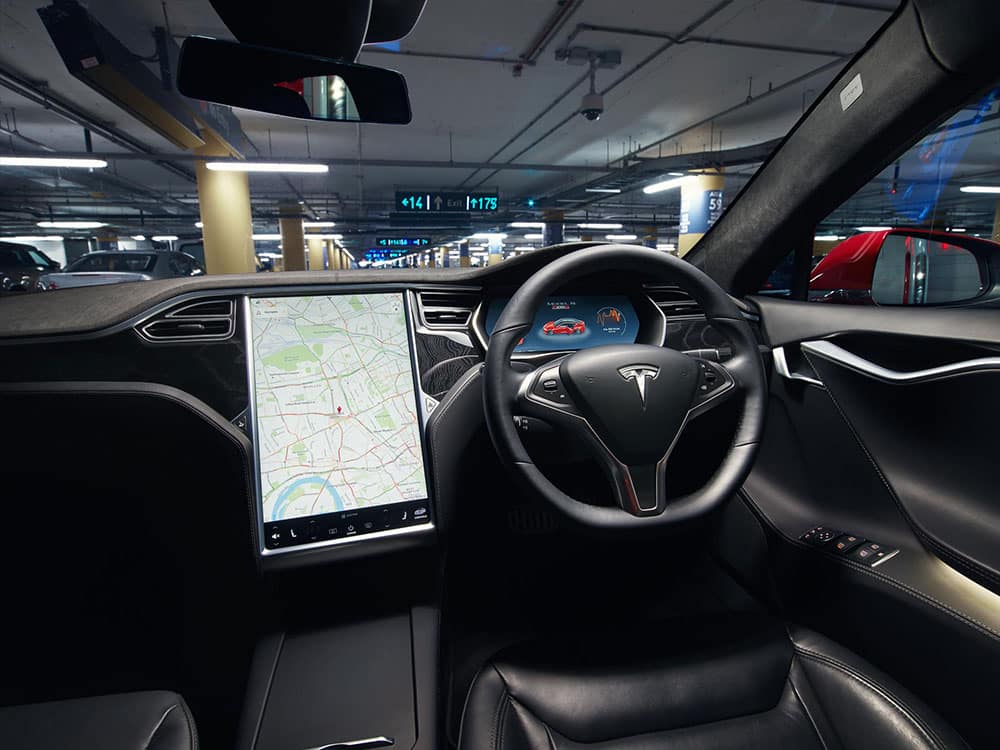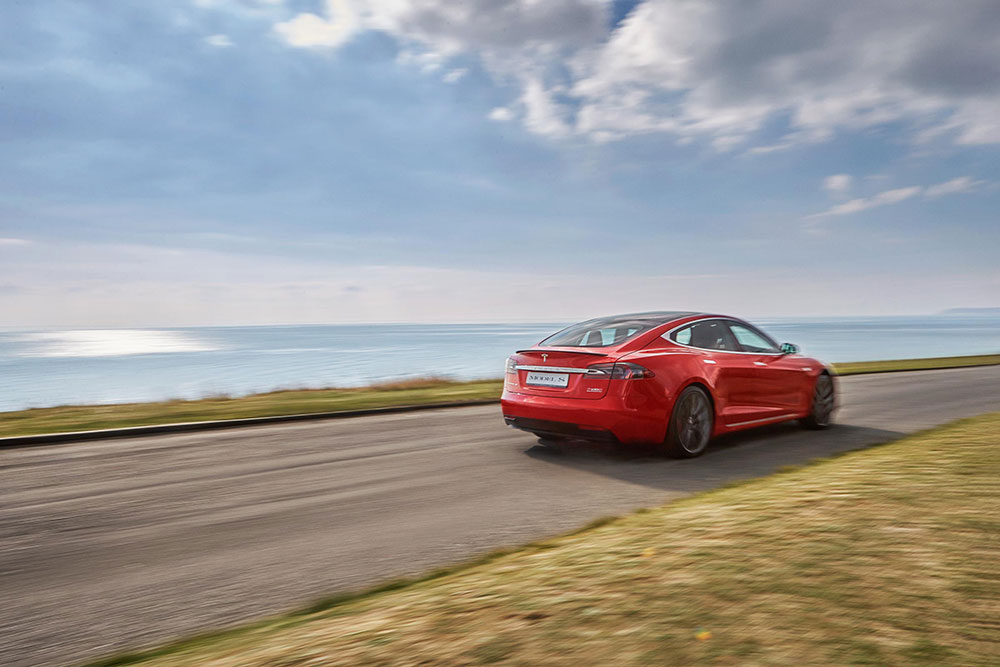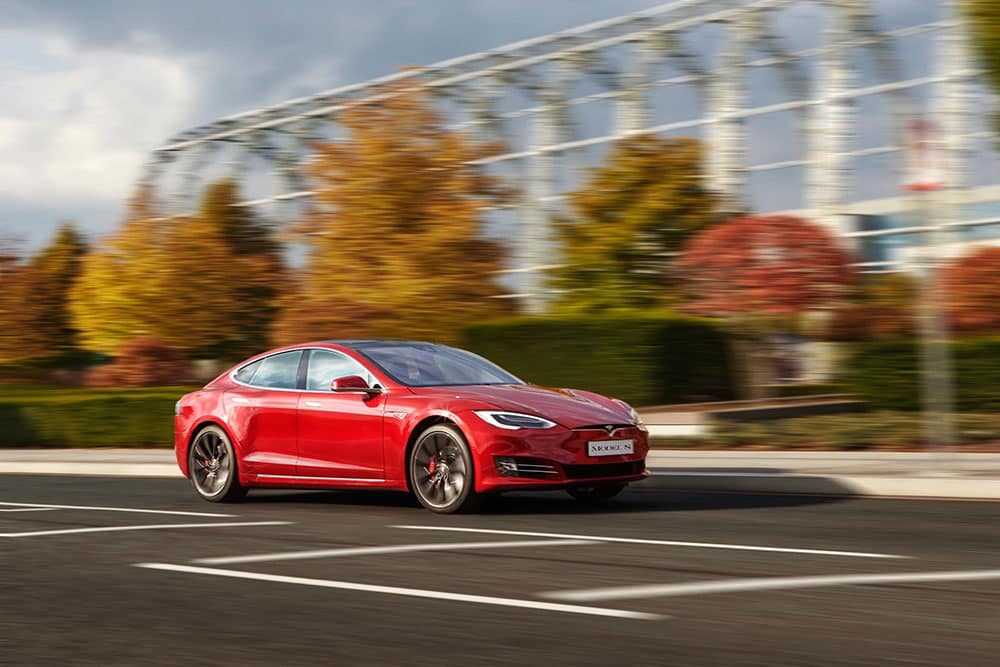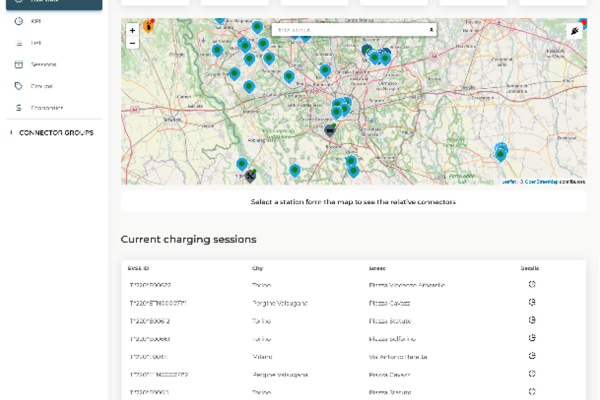- P11D Value: £91,080
- BIK Band 2018/19: 13%
- Luxury executive five-door car
- Dual electric motor 100kW / All wheel drive
- Economy (range – emissions): 393 miles – 0g/km
- Performance (0-62mph/Max speed): 4.1 seconds / 155mph
IF you are in any doubt whether an electric car is a viable proposition for business use, don’t be. It doesn’t require a huge shift in driving habits to make it work in the real world, and with the Tesla you do get quite a lot in return.
What do you get?
The Tesla Model S is a 21st century executive car: Luxuriously furnished, utterly contemporary, elegantly styled, and intoxicatingly powerful. Comparing it with high end saloons from the likes of Porsche or Maserati feels a little presumptuous given the history behind those names, but it’s also strangely apt.
There are obvious differences that give the Tesla a unique character, but there is also much that is reassuringly familiar. The comfort, the quality, the level of equipment, the performance, all can be compared favourably. The only thing you can’t compare is exhaust notes, which turns out to be a surprisingly bearable price to pay.
The Tesla Model S 100d is the mid-range option, if such a term can be applied to a luxury car. It sits between the 75d and the performance P100d with its Ludicrous mode – 2.5 seconds to 60mph – that may sound fun but really isn’t necessary.
The 100d offers greater range than the 75d, and costs around £35k less than the P100d, so it’s probably safe to say this is the sensible choice.
On the technical side the 100kW battery powers two electric motors, one at each end of the car, giving the 100d all-wheel drive.
The instant torque from the motors gives the 100d incredible responses. The limited top speed of 155mph and the ability to hit 60mph in just four seconds helps it keep pace with those aforementioned rivals. The adjustable air suspension is quite a useful addition too, enabling you to smooth out the worst of the bumps or lower the whole car for more responsive handling. You can do the same to the steering with relaxed or responsive modes.
For all this Tesla still claim an official range of 393 miles on a full charge. If driven carefully at all times it may be possible to get close to that number, but in reality we don’t drive like that. Real world figures in excess of 300 miles are certainly achievable though, and with a growing network of Tesla Supercharger sites around the country longer journeys aren’t an issue.
The interior is incredibly bright and comfortable, largely down to the full panoramic roof that is standard on the Model S. Mix the extra sunlight with the white or cream leather finish of the premium trim and the feel is very contemporary, opt for the black and it becomes much more formal.
Either way it’s a refined and impressive cabin with plenty of space, and exceptionally comfortable seats. Tesla also provide a large 17-inch touchscreen set vertically in the centre of the console that is simple and intuitive to use. Vehicle set-up, navigation, media, telephone, and even a 4G web browser, are all available via the central touchscreen.
Why should you choose a Tesla 100d?
- The most logical place to start is the exterior, which is excellent. The Model S has the poise, elegance, and presence to make it one of the most striking saloons on the road. The absence of an engine allows for a lower profile at the front providing an impressively sleek silhouette. The rear is wide – useful for containing the cavernous boot space – and gives the Tesla an air of solidity and purpose. It really is a very attractive.
- It’s impossible to ignore the most compelling aspect of the Model S 100d, the exhilarating driving experience. There are better handling executive saloons around, although the Model S is still very good, and there are more powerful options with higher top speeds, although the Tesla could undoubtedly be turned up to 11. But for all that there is something intoxicatingly different about accelerating this quickly, and in utter silence. The instant power from the electric motors makes the Tesla an easy car to drive on any road. It will cruise effortlessly at motorway speed, and is capable of overtaking with remarkable alacrity.
- Connectivity and technology are a big deal for Tesla. As well as offering over-the-air software updates that ensure your car stays current, the 17-inch touchscreen also allows you to access the internet anywhere the built-in 4G can find a signal. The fact it also has Bluetooth connectivity and USB sockets front and rear should be a given. Add the natural light and the cabin of the Tesla is not only comfortable but also a practical place to work. If you’re in a more relaxed mode the addition of Spotify access via the DAB radio is a touch of genius – no CD clutter or MP3 connections, just instant access to almost every song ever written at your fingertips.
- It may be stating the obvious but the Tesla is electric. As well as the environmental benefits electricity carries well documented financial rewards too. A 13% BIK rate, lower car tax, no congestion charges, no fuel costs, do we need to go on? The Model S demonstrates the potential of an electric car, and also proves you don’t need to sacrifice on quality. Did we mention the electric motors also make it stupendously quick?
- If you can afford to buy one for your business, then you’ll get 100% first year allowances
What’s the downside of a 100d?
- While the Tesla Model S is a very good car it would be folly to describe it as anything other than expensive. Prices for the 75kW model start at £64,700 but the longer range of the 100d takes the price to £86,200. Once you browse the options list – concise though it may be – the ticket price could conceivably hit six If this is your company car that is going to impact your tax rate.
- Now that’s out of the way the rest of this may sound a bit petty, largely as a consequence of there not being much of particular importance to highlight. Overall the Tesla is very good, which inevitably draws your attention to the little things that aren’t. Or in the case of the steering wheel, the things that are a just a little bit too big.
- Or in the case of the storage, all in the same place. The large boot, split rear seats, and extra storage at the front where the engine would traditionally sit means the Tesla is very practical. There is also a 7-seat option with rear-facing child seats that fold up from the boot floor. If only the internal storage wasn’t all situated in the centre console, which is partially hidden by the arm rest and beneath a sliding cover that doesn’t quite slide far enough out of the way. Too many cubbyholes would spoil the elegance of the interior but a bit more variety would be useful.
- There is also a downside to the silent operation of the Model S 100d, apart from highlighting how noisy some of our roads are. In a car that accelerates this quickly the engine note is a useful, albeit subconscious cue to your current speed. Remove the audible reminder and it’s very easy to look down and find yourself travelling significantly faster than you anticipated. It pays to tread carefully in a Tesla.

Verdict on the Tesla Model S 100d
As an executive car the Tesla Model S 100d is a remarkable piece of engineering. It’s sleek and contemporary but retains a luxurious feel, powerful and exhilarating to drive, and a supremely comfortable way to travel. But as an electric car it needs to work in the real world for it to be worth serious consideration.
We have to say, it can and it does. Being able to travel 300 miles plus on a single charge leaves the Model S lagging behind diesel alternatives, but this kind of performance usually involves petrol and that allows the Tesla to close the gap. It’s true that recharging the battery requires more time than refilling a fuel tank but it doesn’t need to impact on journey times as significantly as you may think.
The navigation system will automatically direct you via a Supercharger should you plan a journey longer than the range. If you have already covered a few hundred miles the thought of stopping to recharge the car – and yourself – will likely be a welcome one. It’s also worth bearing in mind that once you’ve connected the cable, an action that literally requires a few seconds, you can walk away. Try this at a traditional petrol station and you will get a few strange looks, and no fuel.
When we plugged our test car into a Tesla Supercharger it went from 30 percent to full in 62 minutes. You can time your stops according to how much charge you need, but even the time it takes to grab a coffee is enough to add quite a few miles to the range. There’s even an app you can install on your phone that allows you to check the battery level without having to go outside.
If further proof were needed, in the hour our car took to fully charge six more Tesla’s came and went, all driven by respectable looking, be-suited individuals who clearly weren’t stopping at a garden centre near Exeter to pick up a few hardy perennials to brighten up their next meeting. If the Tesla wasn’t a viable business option we suspect we would have had the chargers to ourselves.
Speaking of which there is another point worth mentioning. You can plug your Tesla into a regular three-pin plug and it will charge quite happily.
What it won’t do is charge very quickly. We know because we tried it and in 12 hours we gained a miserly 70 miles of range.
A regular household supply will charge at a rate of between four and six miles of range per hour of charge compared to around 300 miles per hour from a Supercharger. While installing a Supercharger in your garage isn’t an option you can have a wall charger fitted at home or at work, or both, whichever suits you best.
A rapid wall charger can provide up to 16.5kW, which translates to around 50 miles per hour of charge. The exact charging rate you can achieve varies according to the laws of physics and the wiring in the building in question. Worst case scenario you might only get the basic 7.5kW but that still means an average overnight charge can add more than 200 miles to your range. It’s a matter of moments to connect, and keeping the battery topped up is the trick to making the Tesla work for you.
Given that a rapid wall charger will cost around £500 plus fitting – and bear in mind the Model S also qualifies for a government grant of up to 75% or £500 of the total cost – it would be astonishingly short sighted for any Tesla driver not to have one installed.
So if the 100d is perfectly usable in the real world the only sticking point might be the cost.
Realistically most people will be shopping around for a car lease deal, which helps mitigate the list price and makes it a much more attractive option. Depending on the exact specification you should expect lease prices around £1,000 per month, and the lower tax rate and running costs should make the Tesla Model S 100d perfectly viable for company owners and directors looking for something different. The high P11D value may have an impact on your tax liabilities but the 13% BIK rate and low running costs should offset this sufficiently to make it worth your while.
If not, did we mention it’s also a bit quick?

Tesla Model S options list
Paint: Solid Black as standard
Metallic paint (Midnight Silver, Black, Blue, Silver) £950
Multi-Coat (Pearl White, Red) £1,400
Wheels: 19-inch silver wheels as standard
19-inch Sonic Carbon Slipstream wheels £1,400
21-inch Sonic Carbon Twin Turbine wheels £4,200
Sunroof option (Panoramic roof as standard) £1,900
Interior – Black fabric as standard
Carbon Fibre Décor £250
Premium Upgrade package £4,700
Includes medical grade HEPA filters, carbon purification filters to keep exhaust particles out of the cabin, and a Bio-Weapon Defence mode that creates a positive pressure in the cabin. Also includes a custom audio system and sub-zero weather features such as heated wipers and washers, heated steering wheel, and heated seats front and rear.
Enhanced Autopilot £4,700
Includes self parking, automatic lane change, more sensors to monitor the vehicle, and the ability to drive the car out of a garage or tight parking space remotely. Not all of these functions are available in the UK at the moment. The package provides the necessary technology which can then be turned on in as more functions become available.
Full self driving capability £2,800
Like the autopilot functions this isn’t currently available in the UK. Essentially this is the opportunity to future proof your Tesla. Selecting this option means that as the technology and regulations regarding self driving vehicles develop these functions are installed and ready to be enabled.
Rear-facing child seats £3,800
A pair of seats under the boot floor that can be raised to create a 7-seater.
19-inch winter tyre set £2,200
A set of standard 19-inch wheels fitted with Pirelli Winter Sottozero Series II tyres for improved stability and traction in snowy conditions.







